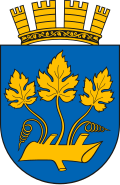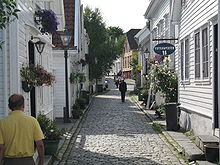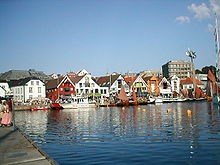Stavanger
| coat of arms | map | |
|---|---|---|

|
|
|
| Basic data | ||
| Commune number : | 1103 | |
| Province (county) : | Rogaland | |
| Administrative headquarters: | Stavanger | |
| Coordinates : | 58 ° 58 ′ N , 5 ° 44 ′ E | |
| Surface: | 262.52 km² | |
| Residents: | 143,574 (Feb 27, 2020) | |
| Population density : | 547 inhabitants per km² | |
| Language form : | neutral | |
| Postal code : | 4005-4034 | |
| Website: | ||
| traffic | ||
| Railway connection: | Jærbanen | |
| politics | ||
| Mayor : | Kari Nessa Nordtun ( Ap ) (2019) | |
| Location in the province of Rogaland | ||

|
||
Stavanger ( [ staˈvaŋər ] ) is the fourth largest city in Norway with 143,574 inhabitants (as of February 27, 2020) . It is located in North Jæren in the Fylke (province) Rogaland and is an independent municipality .
geography
Stavanger is on the mainland and the built-up islands Hundvåg , Buøy , Austre Åmøy, Langøy, Bjørnøy, Roaldsøy, Ormøy , Steinsøy , Engøy , Sølyst , Grasholmen , Vassøy, Lindøy , Hellesøy, Tunsøy and Kalvøy. Then there are the islands of the municipalities of Finnøy and Rennesøy , which were incorporated in 2020 .
The total area is 262.52 km², with 54.19 km² on the mainland. Inland waters together make up 6 km². The largest are Store Stokkavatn (2.19 km²), Hålandsvatnet (0.63 km², Stavanger's share) and Mosvatnet (0.46 km²). In the middle of the center next to the cathedral is the Breiavatnet (0.031 km²).
The highest point in Stavanger is Jåttånuten (139 m above sea level), followed by Ullandhaug (138 m above sea level), on which the Ullandhaugtårnet tower, which can be seen from afar, stands.
Surroundings

There are many ski areas near the city as well as the Lysefjord with the Pulpit Rock, a large overhanging rock.
City structure
The districts are named as follows:
| district | population |
|---|---|
| Hundvåg | 13 178 |
| Tasta | 15 541 |
| Eiganes and Våland | 24 512 |
| Madla | 21 490 |
| Storhaug | 17 423 |
| Hillevåg | 19 987 |
| Hinna | 22 870 |
| Finnøy | 3 228 |
| Rennesøy | 5 090 |
| Districts not specified | 255 |
| total | 143 574 |
climate
| Stavanger | ||||||||||||||||||||||||||||||||||||||||||||||||
|---|---|---|---|---|---|---|---|---|---|---|---|---|---|---|---|---|---|---|---|---|---|---|---|---|---|---|---|---|---|---|---|---|---|---|---|---|---|---|---|---|---|---|---|---|---|---|---|---|
| Climate diagram | ||||||||||||||||||||||||||||||||||||||||||||||||
| ||||||||||||||||||||||||||||||||||||||||||||||||
|
Average monthly temperatures and rainfall for Stavanger
Source: wetterkontor.de
|
|||||||||||||||||||||||||||||||||||||||||||||||||||||||||||||||||||||||||||||||||||||||||||||||||||||||||||||||||||||||||||||||||||||||
history
Traces of prehistoric times have been preserved in the rock carvings by Rudlå .
Stavanger received city rights with the establishment of the bishopric between 1122 and 1125. Construction of the cathedral began during the tenure of the first bishop, Reinald fra Winchester , and since then 1125 has been the usual year of the city's foundation. At that time there were two streets on the east side of Vågen . Besides the cathedral, the Kongsgården (the royal court) , which served as the bishop's residence, and the Olav Monastery, along with the St. Olav Church, were the most important buildings. The diocese of Stavanger comprised areas that had previously belonged to the diocese of Bjørgvin , and extended from Haugesund in the west to Gjernestangen between Risør and Kragerø , and later to Eidanger .
On August 16, 1425, Stavanger received full market rights, but the population remained low. It was not until the 17th century that the number of residents grew from 800 by 1600 to more than 1460 before the great fire in 1684. According to a census carried out in 1700/01, the city had 1,385 people, of whom 524 were children, 356 men, 307 were married Women, 102 unmarried women, 77 female and 19 male young servants; 126 of the adult men had citizen status.
Like many other European and, no less, Norwegian cities of the time, Stavanger suffered severe crises caused by epidemics, fires and economic fluctuations. In 1618 and 1629 the plague raged in the city. In 1633 two thirds including the medieval old town burned down. In 1684 a fire broke out so devastatingly that it was decided to give up the city completely. In 1671, important city representatives ( mayor and lagdomstolen ) moved their seat to Kristiansand , and in 1682 the bishopric followed. In 1686 it also lost its market rights, but regained it in 1690 after it was rebuilt by the population. In 1695 around 15 percent of the population died of typhus. The city was also hit by a series of fires, the most momentous of which occurred in 1716, 1766, 1768, 1833 and 1860; Reason for the fact that the oldest house in the city dates from the 18th century.
It was not until the 18th century that an economic upswing began to ensure the city's steady growth. Stavanger first flourished through fishing (herring), later shipping, and finally the canning industry.
The population increased ninefold in the 19th century: from 2,406 (3,916 within today's city limits) in 1801 to 36,202 in 1900. As the population grew, numerous religious communities began to establish themselves. In 1818 the Quaker community was formed , in 1842 the Norwegian Mission Society ( Norske Missions Selskap ) was founded from the merger of older associations, and in 1844 the Norwegian Mission to Israel ( Den Norske Israelsmisjon ) was founded.
On July 4, 1825, the sloop “Restoration” drove with 52 emigrants from Stavanger to New York , the start of a great wave of Norwegian emigration to the USA.
From 1896 to 1919, Hurtigruten ships called at Stavanger's port .
The city remained an industrial city until the beginning of the 1950s, when it gradually turned into an administrative center. After the oil discovery in the 1960s, it changed into a modern city. Today around 200,000 people live in its metropolitan area .
On January 1, 2020, the municipalities of Finnøy and Rennesøy were incorporated into the municipality of Stavanger.
politics
City Councilor and Mayoress
The city council as the highest municipal body consists of 67 people. The last local election took place on September 9, 2019.
| Seats on the Stavanger City Council | ||||
|---|---|---|---|---|
| Political party | 2011 | 2015 | 2019 | |
| Workers' part | 19th | 18th | 18th | |
| Høyre | 23 | 19th | 16 | |
| Folkeaksjonen nei til mer bompenger | 0 | 3 | 6th | |
| Fremskrittspartiet | 9 | 7th | 6th | |
| Miljøpartiet De Grønne | 1 | 4th | 4th | |
| Rødt | 1 | 1 | 4th | |
| Kristelig Folkeparti | 4th | 4th | 3 | |
| Senterpartiet | 1 | 1 | 3 | |
| Sosialistisk Venstreparti | 3 | 3 | 3 | |
| Venstre | 5 | 6th | 3 | |
| Pensjonistpartiet | 1 | 1 | 1 | |
Mayor of Stavanger since 2019 Kari Nessa Nordtun of the Social Democratic Arbeiderpartiet .
Town twinning
The following cities are twin cities of Stavanger:
|
Culture
The art school in Rogaland , founded in 1978, is based here.
Every year in May the MaiJazz Festival takes place, a major international event for jazz music since 1989, as well as the International Chamber Music Festival founded in 1991 at the beginning of August.
Stavanger was awarded the title of European Capital of Culture together with Liverpool in 2008 .
See also: Stavanger Declaration on the Future of Reading
Attractions
The center of the city is the cathedral ( Stavanger domkirke ), which was built from 1125. It is the only original medieval cathedral in Norway in the Anglo-Norman Gothic style. The old city center east of the old port and the Gamle Stavanger (old Stavanger) district form the historic center. Gamle Stavanger around Øvre and Nedre Strandgate is defined by carefully tended wooden houses from the 18th and 19th centuries, painted white. In the largest wooden house settlement in Gamle Stavanger there is the Norwegian Canning Museum ( Norsk Hermetikkmuseum ) in a former canning factory . The Stavanger Concert Hall is north of Gamle Stavanger .
In the Norwegian Oil Museum , inaugurated in 1999, the history of oil production in Norway and in some other countries is depicted in great detail. Many models and original equipment are exhibited, a walk-in mini drilling platform shows the conditions of a real one. There is also the Stavanger Maritime Museum in the city .
On the 139 m high Ullandhaug, Nordic longhouses ( Iron Age Farm Ullandhaug ) from the Migration Period were discovered, reconstructed and made into the archaeological open-air museum Jernaldergården på Ullandhaug .
The landscape around Stavanger also offers a number of attractions. These include the 92 meter high Månafossen waterfall or the longest sandy beach in Norway , the Solastrand.
There are various monuments in the city, including the Alexander-Lange-Kielland-Monument , the Marinedenkmal , Horve-Monument and the Henrik-Steffens-Monument . The swords in the mountain, which is reminiscent of a battle, is particularly well known . The historic Groombrønnen fountain is on Nedre Strandgate Street . The new Tollboden customs office, built in 1905, is one of the city's cultural monuments .
Sports
One of Norway's most successful football clubs is the Stavanger-based Viking Fotballklubb . The city was also the annual venue for the FIVB - Beach Volleyball - Grand Slam from 2005 to 2011 , and before that, an Open of this Federation three years in a row.
The Stavanger Golfklubb (SGK), founded in 1956, hosted the Norwegian golf championships a total of 18 times until 2017. Twice the Nordic and once the Open Nordic Championships took place on the golf course at Lake Stora Stokkavatnet , five kilometers from the center. In 1985 the women met there for the European golf championships.
Infrastructure
education
The University of Stavanger opened on January 17, 2005.
economy
Many international oil companies have their headquarters in Stavanger, including the largest Norwegian company Equinor (formerly Statoil), as most of Norway's oil reserves are about 300 km west in the North Sea . The oldest hotel in town is the Hotel Victoria .
The city is known for the former production of canned food . There were over 50 canning factories in the 1950s, but the last one closed in 2002.
traffic
Although Stavanger has a land connection only to the south, it is very easily accessible by traffic from all directions. There are numerous ferry and car ferry connections from the ship terminal in the old town, mainly to destinations in Ryfylke's fjord landscape to the northeast .
In Vågen , the old harbor, large cruise ships and regular liners from Denmark and Great Britain dock . Since the harbor basin is very deep, the large ships can practically go to the market to anchor there. Tourist boats to the Lysefjord and Pulpit Rock also operate from here . For private boat traffic, there is Norway's largest boat and marina in the Paradis district . The large ferries have been docking in the newly built Risavika port near the village of Tananger in the municipality of Sola since 2011 . This can be reached from the Stavangers campsite about 10 km away via road 509.
The city is connected to the Sørlandsbanen , which comes from Oslo and runs along the entire coast of southern Norway via Kristiansand .
There is a bus terminal next to the train station, from where numerous overland lines connect the area.
The European route 39 leads from the south through Stavanger and offers a direct connection to Bergen via three submarine tunnels and two ferry lines . In addition to the E 39, some other roads in the surrounding region are also toll roads.
A few kilometers outside, in the area of the municipality of Sola, there is Norway's third largest airport ( Stavanger Airport , IATA code: SVG), which mainly serves as a hub between the offshore drilling platforms and the international scheduled flight network. However, there are more and more direct flights to European destinations.
military
The city is the seat of the High Command of the Norwegian Armed Forces , which is located in bunkers built by the Wehrmacht during the Second World War within the Jåttånuten mountain . Outside the mountain, the buildings of the Felles Krigføringssenter ( Joint Warfare Center ) of NATO are immediately adjacent .
Personalities
Web links
- City of Stavanger in Norwegian and English
- Region Stavanger The tourism website for the Stavanger Region (German)
Individual evidence
- ↑ Statistisk sentralbyrå - Befolkning
- ↑ Statistisk Sentralbyrå Norwegian - 10826: Alders- og kjønnsfordeling for befolkningen i de 4 største byene (B) 2001 - 2020
- ^ Jan Patrick Faatz, 2011, Departure into the Promised Land, Munich, GRIN Verlag GmbH hausarbeiten.de
- ↑ Navn på nye kommuner. February 19, 2019, accessed January 18, 2020 (Norwegian).
- ^ Stavanger commune. valgresultat.no, accessed September 10, 2019 (Norwegian).
- ^ Stavanger commune. valgresultat.no, accessed September 10, 2019 (Norwegian).
- ^ Stavanger commune. valgresultat.no, accessed September 10, 2019 (Norwegian).
- ↑ Om Stavanger kommune, Fakta om Stavanger - Stavangers vennskapsbyer , accessed on June 1, 2018
- ↑ maijazz.no
- ↑ icmf.no
- ↑ Innovation Norway, visitnorway.com ( Memento of the original from March 28, 2013 in the Internet Archive ) Info: The archive link was inserted automatically and has not yet been checked. Please check the original and archive link according to the instructions and then remove this notice. The-Region-Stavanger / See-and-experience-in-the-Region-Stavanger / Sights-in-the-Region-Stavanger, April 18, 2013.
- ↑ fivb.org
- ↑ Om clubs. In: sgk.no. Stavanger Golfklubb, 2017, accessed July 17, 2017 (Norwegian).










